Like many cities in China, Shenyang has experienced rapid expansion in the last decade or so, resulting in the move of its administrative and cultural centers southward, including the relocation of the Museum, which traded a round, nondescript building with a rectangular, nondescript building. Below are two pictures of the Museum before and after the move.
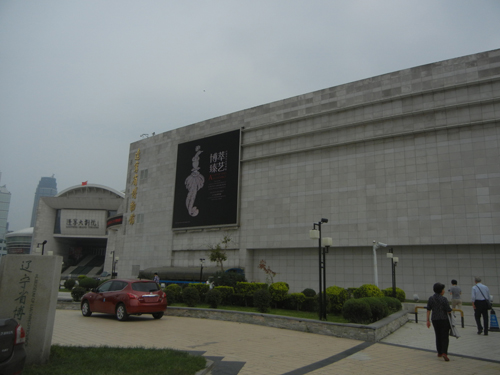
Former site of Liaoning Provincial Museum
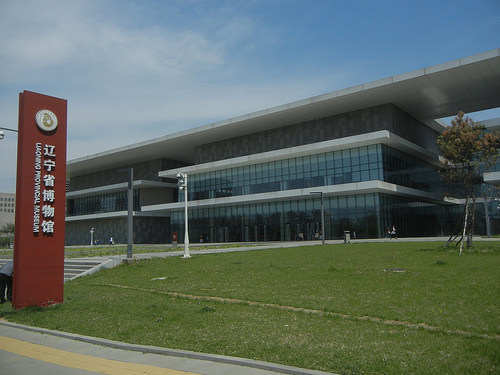
Current site of Liaoning Provincial Museum
The most treasured painting of the Museum was a painting from Tang Dynasty by 周昉 Fang ZHOU, Tang Dynasty, (active 766~779 - 785~804), titled "簪花仕女图 (Court Ladies Adorning Their Hair with Flowers)".
Of my several visits to this museum, I was only able to encounter it once, due to the typical fragility of Chinese paintings, and the preciousness of this piece of extreme sublimity and exquisity, which captured the luxury and easy of the court life during the most prosperous period in Chinese history. The dark and dull background was a perfect foil for the array of richly though never gaudily attired and confidently posed high-ranking ladies and retinue, whose pale skin glittered, underneath their crowning jet black coiffures, while denoting the high ranking of these ladies, together with strategically placed darker veils and belts, created much visual highlights and accents to the otherwise utterly sweet and soft sphere.
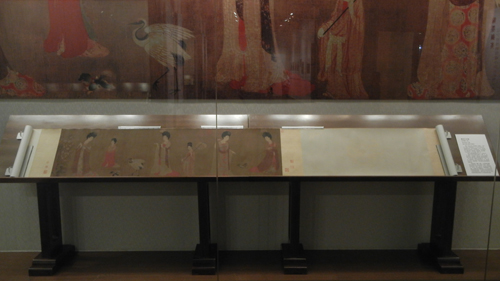
簪花仕女图 Court Ladies Adorning Their Hair with Flowers
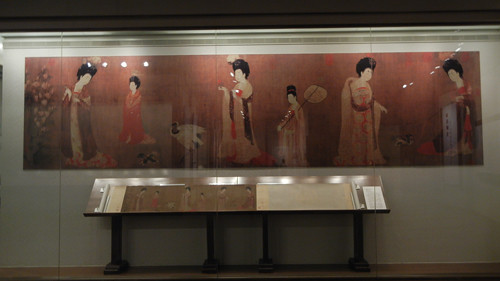
Enlarged replica of 簪花仕女图 Court Ladies Adorning Their Hair with Flowers
Another striking painting was "红衣西域僧图 (Red Robed Western Monk)" by 赵孟頫 Mengfu ZHAO (1254-1322) of Song Dynasty. Here, the western world meant Western Asia. The painting was interesting, not only for the sitter, who was obviously exotic-looking to Chinese, but also the composition and the employment of a single viewpoint, which was more typical in western art idioms. The triangle form of the monk, the rock and the tree behind him, almost invoked a feeling of Italian Renaissance painting, and the single and closeup viewpoint was also an abrupt departure from Chinese painting tradition of a multiple viewpoints, such as the painting above. Here, instead of showing a huge swatch of landscape, and the complete form of the tree, the painter chose to show only the tree trunk and a few barely visible leaves and branches on the very edge of the painting, thus forcing the viewers to concentrate on the figure. Instead of a picturesque tableau, the painting became a character study, via his upright posture, his brilliant red robe, which contrasted strongly to and complemented by the verdant, moss-covered rocks, whose strangely lined surfaces per chance also echoed the monk's weathered and wise face and irregularly shaped head. An unforgettable glimpse of his inner world.
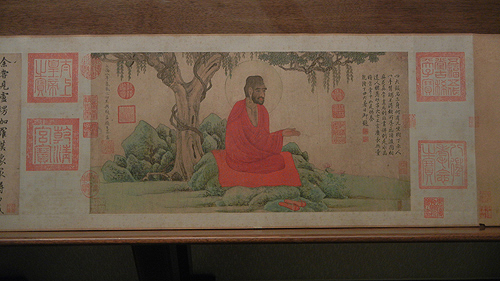
红衣西域僧图 (Red Robed Western Monk)" by 赵孟頫 Mengfu ZHAO (1254-1322)
My Favorite Museum Collection Series
>> My Favorite Museum Collection Series 127: My Favorite Paintings at National Art Museum of China, Beijing
<< My Favorite Museum Collection Series 125: My Favorite Paintings at Pinacoteca Nazionale di Ferrara, Italy
List of My Favorite Artworks in the Museums I've Visited
Other Related posts on Art · 文化 · Kunst:
- Treasure in Liaoning Museum, Shenyang, China
- Art Gallery of Luxun Art Academy in Shenyang, China
- Tram and Subway in Shenyang, China
- Making and Framing Art in Shenyang and US
- Rooftop Vegetable Garden in Shenyang, China
- Lunar New Year Time in Shenyang, China
- Fifteen Authors Influenced Me Most and Watching Shakespeare in China





No comments:
Post a Comment